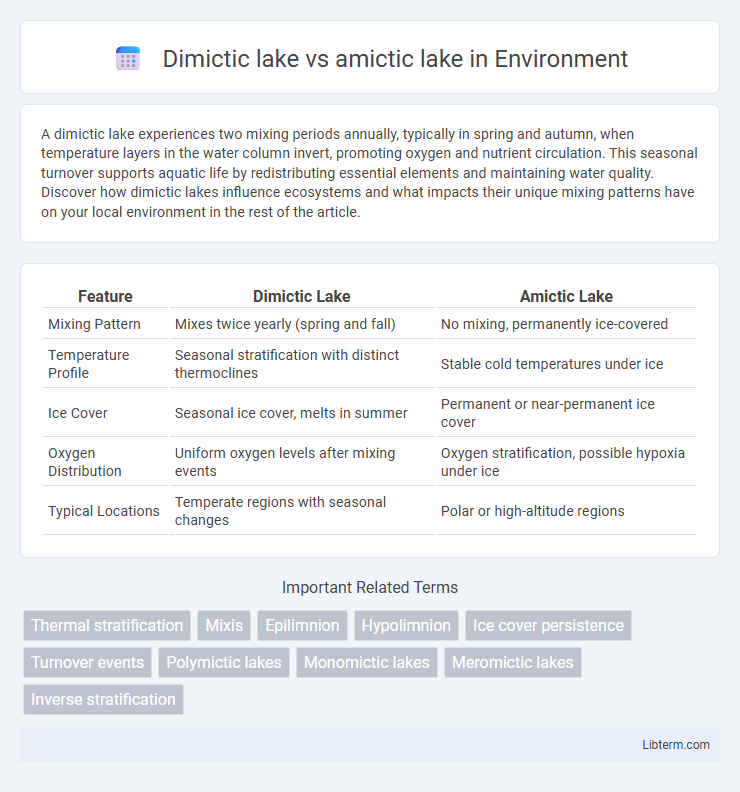A dimictic lake experiences two mixing periods annually, typically in spring and autumn, when temperature layers in the water column invert, promoting oxygen and nutrient circulation. This seasonal turnover supports aquatic life by redistributing essential elements and maintaining water quality. Discover how dimictic lakes influence ecosystems and what impacts their unique mixing patterns have on your local environment in the rest of the article.
Table of Comparison
| Feature | Dimictic Lake | Amictic Lake |
|---|---|---|
| Mixing Pattern | Mixes twice yearly (spring and fall) | No mixing, permanently ice-covered |
| Temperature Profile | Seasonal stratification with distinct thermoclines | Stable cold temperatures under ice |
| Ice Cover | Seasonal ice cover, melts in summer | Permanent or near-permanent ice cover |
| Oxygen Distribution | Uniform oxygen levels after mixing events | Oxygen stratification, possible hypoxia under ice |
| Typical Locations | Temperate regions with seasonal changes | Polar or high-altitude regions |
Introduction to Lake Thermal Stratification
Dimictic lakes undergo two distinct mixing periods annually, typically during spring and autumn, resulting from seasonal temperature shifts that disrupt thermal stratification. In contrast, amictic lakes remain permanently ice-covered, preventing any stratification turnover due to their continuous cold temperatures. Understanding these lake types is crucial for studying thermal stratification patterns, oxygen distribution, and ecological dynamics in freshwater systems.
Definition of Dimictic Lakes
Dimictic lakes are freshwater bodies that undergo two complete mixing periods annually, typically during spring and autumn, when temperature stratification breaks down. These lakes stratify thermally in summer and winter, with distinct layers of water temperature, preventing vertical mixing. In contrast, amictic lakes remain permanently ice-covered and never experience complete mixing throughout the year.
Definition of Amictic Lakes
Amictic lakes are water bodies that do not undergo seasonal mixing due to permanent ice cover, preventing the water from circulating vertically. Unlike dimictic lakes, which experience two mixing periods annually (spring and autumn), amictic lakes remain stratified year-round because the ice acts as a physical barrier. These lakes are typically found in polar regions where low temperatures maintain consistent ice cover.
Key Differences: Dimictic vs. Amictic Lakes
Dimictic lakes undergo two mixing periods annually, typically in spring and fall, facilitating oxygen distribution and nutrient cycling, whereas amictic lakes remain ice-covered year-round, preventing any mixing. Temperature stratification in dimictic lakes fluctuates with seasons, while amictic lakes maintain a constant cold temperature beneath the ice. These differences influence aquatic ecosystems, with dimictic lakes supporting diverse biological activity due to seasonal mixing and amictic lakes often hosting specialized cold-adapted species.
Geographic Distribution of Dimictic and Amictic Lakes
Dimictic lakes predominantly occur in temperate regions with pronounced seasonal temperature variations, facilitating two mixing periods annually during spring and autumn. Amictic lakes are mainly found in polar and high-altitude environments, such as Antarctica and the Arctic, where permanent ice cover prevents seasonal mixing. Geographic distribution of dimictic lakes includes regions like North America, Europe, and Asia, whereas amictic lakes are confined to extreme cold climates with persistent ice cover.
Seasonal Mixing Patterns
Dimictic lakes experience two mixing periods annually, typically during spring and autumn, when temperature-driven density changes promote water circulation from surface to bottom. Amictic lakes, found in permanently ice-covered regions, do not undergo mixing since the ice layer prevents surface water from interacting with deeper layers. The absence of seasonal turnover in amictic lakes leads to stable stratification and limited oxygen renewal in bottom waters.
Ecological Implications and Biodiversity
Dimictic lakes undergo two mixing periods annually, promoting oxygen distribution and nutrient cycling, which supports diverse aquatic ecosystems and enhances species richness. Amictic lakes, typically perennially ice-covered, experience minimal water mixing, leading to stratification that limits oxygen availability and reduces habitat variability, often resulting in lower biodiversity. The contrasting thermal regimes and mixing patterns directly influence ecological productivity and community composition in these lake types.
Water Quality and Nutrient Cycling
Dimictic lakes undergo two complete mixing periods annually, promoting oxygenation throughout the water column and facilitating efficient nutrient cycling that supports diverse aquatic ecosystems. In contrast, amictic lakes remain permanently ice-covered, limiting oxygen exchange and nutrient redistribution, often resulting in nutrient stratification and reduced water quality. The differences in thermal regimes between dimictic and amictic lakes critically influence biogeochemical processes and overall lake productivity.
Climate Change Effects on Lake Stratification
Dimictic lakes undergo two mixing periods annually, typically in spring and autumn, which help oxygenate deep waters and regulate nutrient cycles, but climate change disrupts this pattern by increasing surface temperatures and reducing ice cover duration, leading to longer stratification periods and potential hypoxia. Amictic lakes, which do not mix due to permanent ice cover, are highly sensitive to warming as reduced ice presence alters thermal structure and can trigger unexpected mixing events or stratification breakdowns. Both lake types face intensified disruptions in thermal stratification from rising global temperatures, impacting aquatic ecosystems and biogeochemical processes crucial for maintaining water quality.
Summary and Future Research Directions
Dimictic lakes undergo two complete mixing periods annually, typically in spring and autumn, enabling oxygen and nutrient cycling across depths; amictic lakes remain permanently stratified due to persistent ice cover, limiting mixing and biogeochemical exchanges. Future research should investigate the impacts of climate change on the mixing regimes of these lakes, particularly how shifting temperature patterns alter stratification dynamics and ecosystem health. Advances in remote sensing and in situ monitoring technologies will enhance understanding of temporal variations and guide adaptive management strategies for these distinct lake types.
Dimictic lake Infographic

 libterm.com
libterm.com